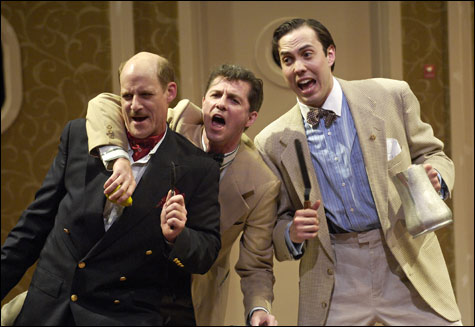
ROUGH CROSSING: Tom Stoppard excels even the manufacture of abject silliness.
|
In
ROUGH CROSSING
, British playwright Tom Stoppard demonstrates that even in the manufacture of abject silliness he’s smarter than anyone else. Stoppard just won a Tony for his heady trilogy The Coast of Utopia — a navigation of Russian intellectual thinking of the mid-19th-century whose components are titled Voyage, Shipwreck, and Salvage. The 1984 Rough Crossing (in repertory at Shakespeare & Company through September 2) is a far frothier seafaring excursion. Adapted from a 1926 comedy by Hungarian playwright Ferenc Molnár by way of P.G. Wodehouse, the linguistically gymnastic but welterweight comedy, with a few catchy ditties by André Previn, is set in the 1930s on a ship bound from Southampton to New York with pithy thespian cargo. In Lenox, on a three-quarter thrust stage festooned with lifebuoys, it’s acted at full stagger by a light-footed sextet of Shakespeare & Company pros negotiating an inane plot that mixes love and dramaturgy, a few marathon-worthy running jokes, and the ever-tipping decks of the SS Italian Castle (a reference to Molnár’s Play at the Castle) in heavy seas. You could ferret out commentary about truth and artifice — or about the nuts and bolts of playwriting — amid all the lurching, lunching, amelioration of the lovelorn, and attempted construction of a bad musical comedy. But, really, Rough Crossing is closer to piffle than Pirandello.
Sandor Turai and Alex Gal are seasoned librettists whose sensitive and stuttering protégé, composer Adam Adam, is in love with the leading lady of their Broadway-bound musical comedy, Slavic bombshell Natasha Navratalova. When the creative team board ship earlier than expected and overhear Natasha getting hot and heavy with old flame and leading man Ivor Fish, Turai fears the traumatized songsmith will bolt. So he takes the eavesdropped-upon seduction and turns it into a ludicrous new ending for the problem-fraught show on which he, Gal, and Adam are collaborating. That way Natasha and Ivor can pretend they were not canoodling but “rehearsing.”
With the exception of the bereft Adam and a breezy ship steward named Dvornicheck, all the characters, theater folk to their toes, are vain and eccentric. And under Kevin G. Coleman’s direction, the S&C troupers, no strangers to the roar of the greasepaint (or to the twisted Shakespearean borrowings Stoppard threads into the script), play their theatrical stereotypes to just short of the hilt, mixing Marx Brothers high jinks with Cowardly sophistication. Whether they’re throwing dramatic snits or forming a sprightly kick line, the performers have fun with the material without rendering it clownish. Jason Asprey, in particular, keeps the antics in check with his terse delivery of cool-hand buffet grazer Gal’s deadpan observations. Jonathan Croy is aptly articulate as the smug Surai. Elizabeth Aspenlieder makes a fetching, wacky-accented Natasha. As Adam, ivory-tickling Bill Barclay marries strangulated geekiness to convincing musicianship. And as the omniscient Dvornicheck, who receives every tossed-off remark as an excuse to down the drink he’s about to serve, LeRoy McClain performs a veritable ballet of tipping, tippling, and exposition.
Up the road at Barrington Stage Company, a superb production of
WEST SIDE STORY
(through July 14) reminds us that it doesn’t get much better than Romeo and Juliet scored by Leonard Bernstein and removed to Manhattan streets that, even at their Eisenhower-era meanest, sizzle in a wash of hot-blooded innocence. BSC begins its first full season in its renovated Pittsfield theater with this operatic production helmed by artistic director Julianne Boyd, with musical direction by Darren R. Cohen, who conducts a pit orchestra of 11. The old-fashioned proscenium house is perfect for the 1957 gem of a show, and Luke Hegel-Cantarella provides a grubby, jagged jumble of soiled brick, broken boards, corrugated tin, and chain-link amid which to house it. Moreover, the production — for which Joshua Bergasse embellishes the muscular and balletic Jerome Robbins choreography — captures both the tragic momentum and the musical ardor of the piece. Is there a more soaring sequence in American musical theater than the one that slides from “Maria” into “Tonight”? And is there a more sharply lyricized novelty number than “Gee, Officer Krupke,” the apprentice work of a 27-year-old Stephen Sondheim?
Here all the Jets and Sharks have distinct personalities, but they dance like a collective dream, whether jutting their way through “Dance at the Gym” or executing the leaps and lifts of the bare-stage-set “Somewhere” ballet. At the heart of the production are Chris Peluso’s dark-browed Tony, his fine voice slipping effortlessly into falsetto, and Julie Craig’s childlike Maria, a pure soul with purer pipes. These two make love-at-first-sight seem something holy — despite being surrounded by nose-thumbing, hormone-gushing agnostics who make the rumble under the highway harrowing and render palpable the subsequent regret of youngsters pumped up on prejudice they didn’t invent. I heard several audience members comment on the way out that they planned to rent the movie. It may be a letdown.